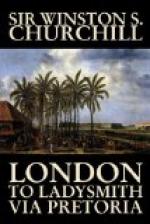I find it convenient, and perhaps the reader will allow me, to break into a more personal account of what followed. It drove us all mad to watch idly in camp the horrible shelling that was directed on the captured position, and at about four o’clock I rode with Captain R. Brooke, 7th Hussars, to Spion Kop, to find out what the true situation was. We passed through the ambulance village, and leaving our horses climbed up the spur. Streams of wounded met us and obstructed the path. Men were staggering along alone, or supported by comrades, or crawling on hands and knees, or carried on stretchers. Corpses lay here and there. Many of the wounds were of a horrible nature. The splinters and fragments of the shell had torn and mutilated in the most ghastly manner. I passed about two hundred while I was climbing up. There was, moreover, a small but steady leakage of unwounded men of all corps. Some of these cursed and swore. Others were utterly exhausted and fell on the hillside in stupor. Others again seemed drunk, though they had had no liquor. Scores were sleeping heavily. Fighting was still proceeding, and stray bullets struck all over the ground, while the Maxim shell guns scourged the flanks of the hill and the sheltering infantry at regular intervals of a minute. The 3rd King’s Royal Rifles were out of reach. The Dorset Regiment was the only battalion not thrown into the fight, and intact as an effective unit.
I had seen some service and Captain Brooke has been through more fighting than any other officer of late years. We were so profoundly impressed by the spectacle and situation that we resolved to go and tell Sir Charles Warren what we had seen. The fight had been so close that no proper reports had been sent to the General, so he listened with great patience and attention. One thing was quite clear—unless good and efficient cover could be made during the night, and unless guns could be dragged to the summit of the hill to match the Boer artillery, the infantry could not, perhaps would not, endure another day. The human machine will not stand certain strains for long.
The questions were, could guns be brought up the hill; and, if so, could the troops maintain themselves? The artillery officers had examined the track. They said ‘No,’ and that even if they could reach the top of the hill they would only be shot out of action. Two long-range naval 12-pounders, much heavier than the field-guns, had arrived. The naval lieutenant in charge said he could go anywhere, or would have a try any way. He was quite sure that if he could get on the top of the hill he would knock out the Boer guns or be knocked out by them, and that was what he wanted to find out. I do not believe that the attempt would have succeeded, or that the guns could have been in position by daylight, but the contrast in spirit was very refreshing.




